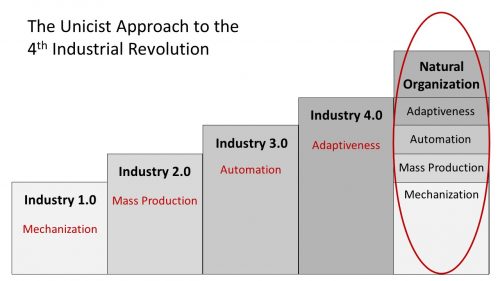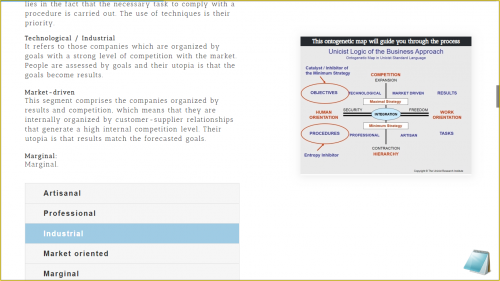Abstract
The unicist solution management systems are expert systems to solve specific problems by managing the root causes of the business functions and develop catalysts to accelerate processes. They are the expert tools of the Unicist Solution Building Factories that are installed in companies. They make diagnoses and develop strategies, solutions, business objects and catalysts to accelerate the speed of growth of businesses, their processes and their markets.

The Solution Management Systems were developed at The Unicist Research Institute to develop solutions in the field of adaptive business processes that are feedback dependent.
They approach the unified field of businesses and their functions to manage their root causes and define what is possible to be achieved and how to make it happen.
They are updated using the Unicist Artificial Intelligence to expand the knowledge based on the experiences of the system.
They provide solutions in the field of action that need to be adapted to the specific conjuncture of the processes involved.
The use of the solution management systems is based on the extreme design methodology that includes the participation of a coordinator, an ombudsman/woman and a fallacy shooter. The use of the Unicist XD methodology sustains the simplicity and reliability of design processes.
The Unicist Solution Management System: A Solution Factory in the 4IR
The solution management systems are the tools of any “Solution Factory” that deals with the root causes of business problems. They were developed to manage the fundamentals of business processes to manage the root causes of processes and develop solutions in adaptive environments.
With multiple specialized modules to solve specific problems, these systems manage the unified field of the business processes to manage their adaptability. The management of adaptive business processes is a turning point in the context of the 4th Industrial Revolution.

They simplify the building of adaptive solutions based on the use of the concepts and fundamentals of processes, an intuitive approach based on the experience of the users and a pilot testing approach that ensures the functionality of results.
The unicist evolutionary approach to the 4th Industrial Revolution is based on managing the unified field of business functions to increase their adaptability, productivity, quality, customer orientation and sustainability.
The unified field is managed by solution management systems with Unicist Artificial Intelligence that use the ontogenetic maps of business functions to manage the concepts and fundamentals of businesses. This approach increases the competitive advantages and fosters growth and profitability.
Main Applications
- Automation Process Design
- B2B Segmentation & Profiling
- B2C Segmentation & Profiling
- Business Catalysts Building
- Business Objects Building
- Business Relationship Building
- Change Management Design
- Co-marketing Strategy Building
- Commercial Objects Building
- Competitive Strategy Building
- Conceptual Design of Processes
- Continuous Improvement Design
- Distribution Channels Building
- Image & Branding Objects Building
- Logistics Design
- Marketing Strategy Building
- Organizational Strategy Building
- Pricing Strategy Building
- Productivity Improvement
- Promotion Strategy Building
- Quality Assurance Design
- Quality Improvement
- Root Cause Management
- Talent Development
The Unicist Root Cause Library

The functionality of things is defined by their underlying concepts. This library gives access to the ontogenetic maps of the concepts and fundamentals that define the unified field of business functions and allow managing their root causes.
It is based on more than 5,000 researches developed at The Unicist Research Institute since 1976.
The unicist evolutionary approach manages the concepts and fundamentals of processes and is synthesized in the unicist strategy and the unicist conceptual management that emulate the intelligence, organization and evolution of nature.
An Action Guide to Manage Complex Problems

The solution management systems provide an action guide to develop solutions in adaptive environments and are also a development space to share the design of the solutions with people who have knowledge and experience in a field.
It is based on providing the information to make a diagnosis of the fundamentals that drive a specific business function and guides the design process providing full transparence that allows managing each stage of the process until the functionality of a solution has been confirmed.
The systems work with the fundamentals of business functions which allow accessing the root causes of processes.
The Diagnostics Module

The system uses a fundamentals-based diagnosis to propose an operational solution that provides a action plan that only requires having experience in the field of the business function that is being managed.
To use this system, it is necessary that the coordinator, the ombudsman/woman and the fallacy shooter understand the fundamentals that are being used.
For this purpose, there is an action guide that provides the full description the system uses to allow people to understand the basics of the solution. If there a more than three participants, the access to the knowledge is optional.
The Structural Solutions Module

The results produced by the system establish a set of synchronic actions that should be functional to solve the problem that is being addressed.
This set of solutions should be compared with the experience and the existing benchmarks of the activity. This comparison is necessarily based on the experience of each participant and requires exchanging interpretations on the forum.
This information provides an image of the whole solution that is being proposed. The steps that follow drive to adapt each aspects of the solution to the specific conjuncture.
The Specific Solutions Module

The generic solutions are transformed into specific solutions that need to be implemented. Therefore, it is necessary to develop specific solution knowing that the resources are available. This requires opening a discussion with the participants of the projects to make sure that the solution can be achieved.
The solution proposed need to be consistent with the basic diagnosis. If they are not it is necessary to edit the input and develop a new diagnosis. This might happen frequently, and the revision should be focused only on the specific aspect that is being solved.
The Operational Solutions Module

Once all the aspects of the function have been solved, it is time for a solution of the problem or of what is being designed. Extreme design is a back2back approach where the participants discuss as equals.
The solutions need to be specific and an action guide for the implementation. It has to be considered that all the solutions deal with adaptive aspects of businesses which makes them feedback dependent.
This approach is based on the possibility of recycling the solution building process three times if necessary. The need for recycling is defined by the results of the pilot tests.
The Pilot Testing Module

The development of pilot test is the core of the success of the design process. There are pilot test for each of the three cycles of the extreme design process. It is necessary to start a new project from scratch is the pilot tests fail.
The feedback of the pilot tests allows improving the solutions that are being build. The core of the pilot tests is to find the dysfunctionality to ensure results.
The first pilot test validates the solution proposed. The second pilot tests validate the 2nd solution including its catalyst and the 3rd pilot test is a destructive test that extends the boundaries of the solution and confirms the limits of its functionality.
The Process of the System

The extreme design methodology was developed to deal with complex business problems in adaptive environments. It basically deals with complex problem solving, complex solution building, business objects and catalysts building and root cause finding and management.
It begins with a diagnosing process based on an operational approach to the fundamentals of business functions, continues with an adaptive process to develop specific diagnoses. The solution building processes includes solutions for specific aspects and the final solution of the project. Finally, the pilot testing process ensures the quality of the solution and its reliability.
About the Unicist Artificial Intelligence
The Unicist Artificial Intelligence Monitor is an intelligent interface that allows organizing adaptive systems and environments and finding the root causes of their functionality. It is based on the use of the ontogenetic maps of business functions that have been researched.
This monitor can work as an artificial substitute for the mental emulation of processes when dealing with adaptive environments. It is also a facilitator of the mental emulation of processes when human management is needed.
The Unicist AI Monitor is driven by a Unicist Inference Engine that is based on the rules of the Unicist Double Dialectical Logic that allows dealing with the evolution of complex adaptive systems and environments.
The double dialectical logic is an emulation of the ontogenetic intelligence of nature that drives the functionality and evolution of complex adaptive systems and environments.
Unicist Artificial Intelligence emulates the human reflection process to apprehend the concepts of complex adaptive systems and environments.
The Unicist AI Monitor allows developing solutions and learning from the pilot tests of their implementation until their functionality has been confirmed. Its intelligence allows emulating solutions based on the unicist ontological structure of business functions using the rules of the unicist double dialectical logic that allow managing the dynamics and evolution of complex adaptive systems and environments.


